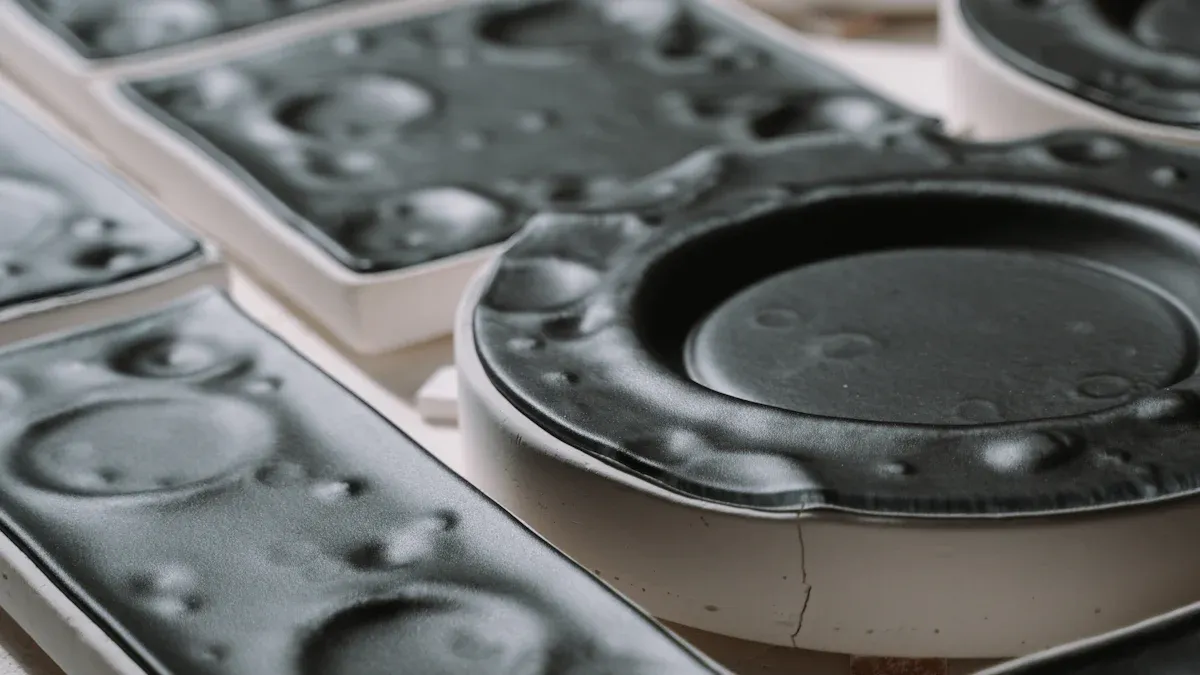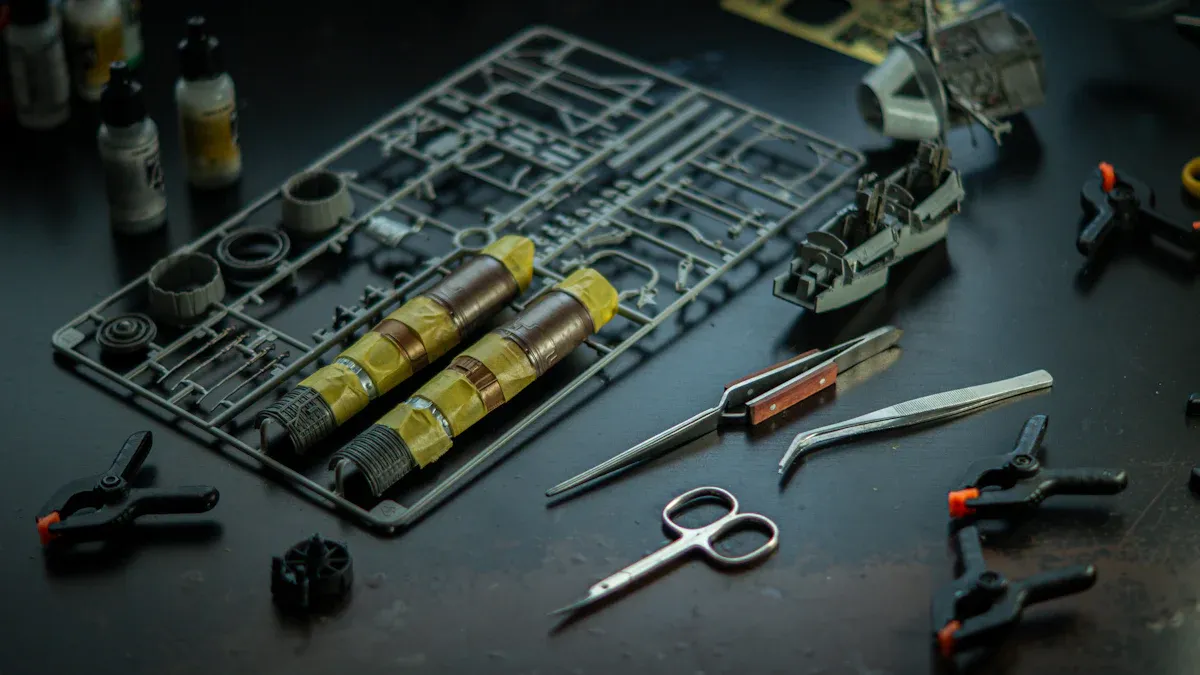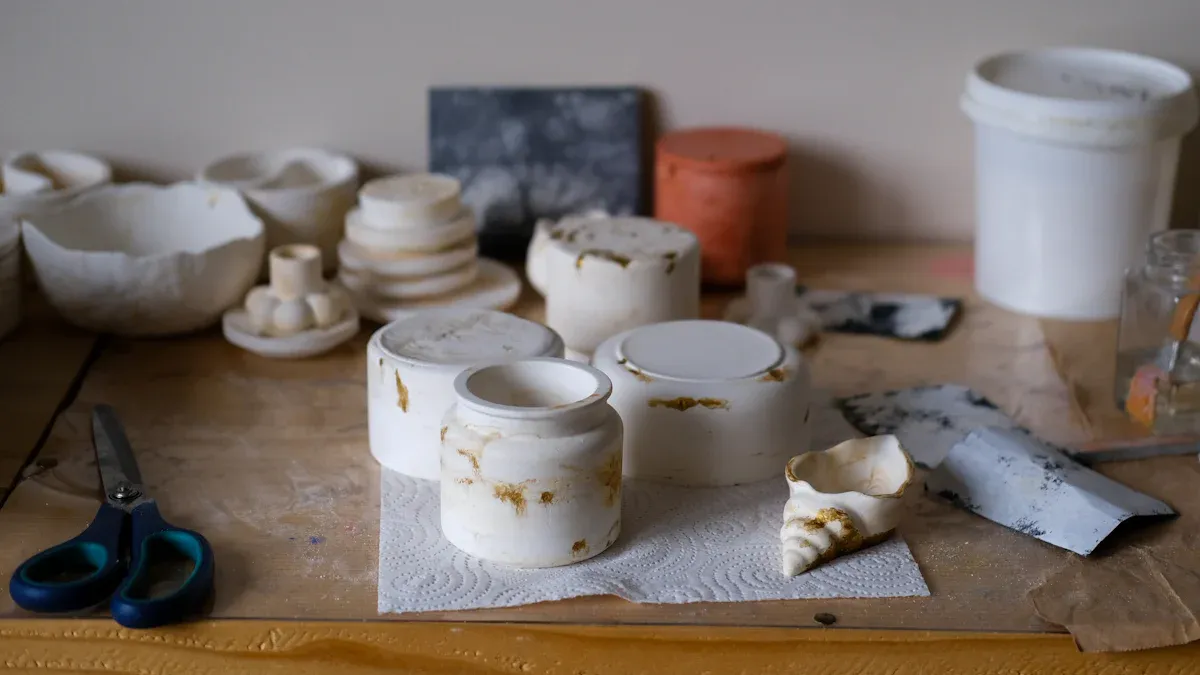What Is a Cavity Mold and How Does It Work in Manufacturing

A cavity mold makes the empty space inside a mold. This space gives the part its outside shape. In manufacturing, the cavity mold helps make products with exact shapes and sizes. Manufacturers use cavity molds to keep quality high and work faster. Studies show that good design of cavity layout and gate sizes can help control pressure and temperature better. These things help lower stress and make products better. Advanced process control in multi-cavity molds can cut part mass changes by 50% and lower size changes by about 40%. Knowing how a cavity mold works helps get the same results every time in mass production.
Key Takeaways
A cavity mold forms the outside of a product. It helps make parts that are the right size and look good.
Multi-cavity molds can make many parts at the same time. This saves time and money. It also keeps the quality the same for each part.
A good cavity mold design is important. The shape, cooling, and surface finish must be right. This makes parts strong, smooth, and easy to take out.
Using strong materials like steel or aluminum helps molds last longer. Taking care of molds keeps them working well.
Checking and cleaning molds often stops problems like cracks, wear, and warping. This helps make better products.
Cavity Mold Basics

What Is a Cavity Mold
A cavity mold is an empty space inside a mold tool. This space shapes the outside of a part. The cavity matches the outside of the finished product. In injection molding, hot plastic or metal goes into the cavity. The material cools and hardens to make the final shape.
The cavity side is also called the A-side. It makes the outside details of the part. If the cavity is made well, the part will look good. Some molds have one cavity and make one part at a time. Others have many cavities and make more parts at once.
The table below shows how the core and cavity are different:
Aspect | Core | Cavity |
|---|---|---|
Definition | Makes the inside features of the part | Makes the outside features of the part |
Function | Makes hollow spots and inside shapes | Makes the outside shape and details |
Location | Sits inside the mold, across from cavity | Sits in the mold, around the core |
Cooling and Ejection | Has cooling channels and may help push out parts | Has cooling channels and may help push out parts |
Material | Usually made from strong steel or aluminum | Usually made from strong steel or aluminum |
Role in Molding | Makes the inside shape of the part | Makes the outside shape of the part |
Shape | Inside shape of the part | Outside shape of the part |
Interaction | Joins with the cavity to make the mold space | Joins with the core to make the mold space |
Design Considerations | Must fit inside features, cooling, and ejection | Must have exact outside size and smooth finish |
Designers focus on the shape, angles, and smoothness of the cavity. These things help the part come out easily and look nice. The cavity also needs good air vents and cooling. This stops problems during molding.
Role in Manufacturing
The cavity mold is very important in making things. It is used in injection molding and metal casting. The cavity shapes the melted material and controls how the product looks and fits. Good cavity design helps make strong and even products.
Mold cavities match the size of the product for correct shapes.
Multi-cavity molds make more parts at once and save money.
Runner systems help the melted material move well. Bad design can cause problems.
Hard cavity shapes can cause lines or air problems that hurt quality.
Special tools check if the parts are always the same, even with tricky shapes.
In injection molding, the cavity gets hot plastic under high pressure. The plastic fills the cavity and takes its shape. Sensors can check pressure and heat inside the cavity. This helps find problems like not enough plastic or too much. Tools like heat cameras and sound tests help find mistakes and fix them.
Manufacturers use different ways to check how well cavity molds work:
Cycle time: Shorter times mean faster work.
Part quality: Good cavities make fewer mistakes and less waste.
Production reliability: Good molds keep machines running.
Uniformity: Balanced molds make every part the same.
Some real examples show how cavity molds help:
Better pin layouts help remove parts with fewer mistakes.
Good clamps keep the mold closed tight and make better parts.
Checking for mold wear helps plan repairs and stop delays.
Some molds use more than one plastic to make better products.
Making lots of small parts at once saves money and time.
Making things like VR headset covers shows how molds help with speed and detail.
Special tools, like X-ray and pressure sensors, help control the molding process. They find empty spots, check thickness, and watch heat changes. These tools help find problems early and make the process better.
In short, the cavity mold shapes the outside of a part. It helps make good products fast in injection molding and other ways. Careful design and checking of the cavity make better parts and lower costs.
Types of Cavity Mold
Manufacturers pick different cavity molds for their needs. Each type helps with speed, cost, or making better parts.
Single Cavity Mold
A single cavity mold has one cavity and one core. It makes one part each time. Companies use this for big parts or new projects. These molds cost less at first and are easy to fix. Workers can watch one part closely to keep it good. This mold is best for small or medium batches.
Single cavity molds are easy to clean and change. They are good for testing or making special parts.
Multi-Cavity Mold
A multi-cavity mold has many cavities and cores that look the same. This lets companies make many of the same part at once. Multi-cavity molds help make more parts fast without more machines. They are great for making lots of parts quickly and evenly.
The table below shows how single and multi-cavity molds compare:
Efficiency Aspect | Single-Cavity Mold | Multi-Cavity Mold |
|---|---|---|
Production Speed | One part per cycle | Multiple parts per cycle |
Cycle Time | Standard per part | Same cycle time, more parts |
Per-Part Cost | Higher | Lower |
Machine Utilization | Less efficient | More efficient |
Initial Mold Cost | Lower | Higher |
Part Consistency | Variable | Improved |
Energy and Labor Costs | Higher per part | Lower per part |
Multi-cavity molds can make work up to 80% faster. They also help every part look the same because all fill at once. The first mold costs more, but each part costs less. This makes them good for making lots of parts.
Family Mold
A family mold has many cavities and cores, but each is a different shape. This mold makes a set of parts in one go. Companies use family molds to make parts that fit together, like a box and its lid.
Family molds save money by making many parts in one mold.
They make it easier to order and change designs.
You can make more parts faster and pay less for each.
These molds are good for small batches and testing.
Using one batch of material keeps all parts the same.
Studies show that good runner design helps fill family molds right. This lowers mistakes and waste. Family molds also help companies get products ready faster.
Family molds help make sets of parts quickly and well. Many businesses find them useful.
Injection Molding Process

Cavity in Injection Molding
The cavity shapes the outside of each part. Machines push hot plastic or metal into it. The material fills the space, then cools and hardens. This gives the product its final shape and size. The cavity must be the right shape and smooth. If not, the part might have problems or not fit right.
Sensors inside the cavity check pressure and filling time. These sensors help workers see how the melted material moves. They can find problems like air bubbles or uneven filling. Mold flow analysis software also helps. It shows how resin moves and cools inside the cavity. This software can predict problems before making real parts. Engineers use these tools to fix issues early and make molding better.
A tracking system can watch how fast the melted material moves. This helps workers see if the flow is smooth or slow in spots. By checking these things, companies can make better parts and waste less.
Mold Materials
The mold material affects how well the cavity works. Most molds use strong metals like stainless steel or hardened steel. These metals last long and keep their shape after many uses. Some molds use aluminum for faster cooling and lower cost. But aluminum wears out faster.
Sheet metal can make simple molds for small batches. The mold material depends on part size, how many parts are needed, and the type of melted material. The cavity shape also matters. A study looked at how different shapes affect heat transfer. The table below shows the results:
Aspect | Details |
|---|---|
Cavity Shapes | Rectangular, Trapezoidal, Wavy |
Best Performance | Rectangular shape keeps the lowest base temperature and works best overall |
Heat Transfer | Taller cavities use more heat diffusion; wavy shapes melt slower due to thicker walls |
Material Used | Nano-enhanced phase change material with copper oxide nanoparticles in paraffin |
Practical Implication | The shape and material of the cavity change how the molten material cools and hardens |
The right mold material and cavity shape help control the process. They make products better and help the injection molding process work well.
Mold Design
Cavity Mold Design
Engineers look at many things when making a mold cavity. The shape of the cavity decides how the part will look. It also changes how the melted material moves inside. Draft angles help parts come out of the mold easily. If there is no draft, parts can get stuck or break. The mold must be made from strong metals like hardened steel or aluminum. These metals help the cavity stay the right shape after many uses.
Today, engineers use computer tools like Moldflow to help design molds. These tools let them test where to put gates and runners. They also help plan where to put cooling channels. This helps find problems like uneven filling or hot spots before making the mold. Special cooling systems, like conformal cooling, help keep the cavity at the right temperature. This stops mistakes and keeps the process steady. New ways like additive manufacturing let engineers make tricky shapes and custom designs. This helps them make test molds faster.
Engineers also plan how the core and cavity fit together. A good design makes sure the mold closes tight and the part is made right. Ejection systems must work well so parts come out without breaking. By watching the heat and pressure, engineers can stop problems like short shots or sink marks. These steps help make good parts that are always the same.
Tip: Making the heating and cooling channels better in the mold cavity can help make more parts faster and keep the temperature even. This makes the parts better.
Surface Finish and Precision
How smooth or rough a part is changes how it looks and works. There are rules, like SPI and VDI, that tell how smooth a part should be. SPI grades go from A for shiny to D for rough. Each grade uses a different way to finish the surface. For example, diamond buffing makes a shiny part. Sandpaper or stone powder makes a dull or matte part. VDI uses numbers to show how rough or smooth a part is, especially for EDM finishes.
SPI Grade | Method | Typical Use | |
|---|---|---|---|
Glossy | A-1 | Diamond buffing | Lenses, visors, high aesthetics |
Semi-gloss | B-1 | Sandpaper | Consumer parts, smooth surfaces |
Matte | C | Stone powder | Hides marks, affordable |
Engineers pick the right finish for what the part needs to do. They also think about what the part is made from and how the mold is built. Sometimes, they change the draft angle if the surface is rough. After molding, they might paint or polish the part to make it look better. By following these rules, companies make sure every part is the right shape and has the right finish.
Note: A good surface finish and careful cavity design help stop mistakes and make sure every part is made right.
Core and Cavity
Core vs. Cavity
In mold making, core and cavity do different jobs. The core makes the inside shapes of a part. The cavity shapes the outside of the part. Both work together to make the final product look right. The core sits in the middle of the mold. It forms holes, ribs, or other inside shapes. The cavity goes around the core. It gives the part its outside look and feel.
The table below shows how core and cavity are not the same:
Aspect/Component | Core Side | Cavity Side |
|---|---|---|
Role | Forms internal features of the molded part | Shapes external surfaces of the molded part |
Surface Focus | Interior features | Exterior features |
Design Influence | Structural integrity, supports internal ribs | Aesthetics, surface texture, and finish |
Cooling Characteristics | Higher thermal mass, slower cooling | Requires faster cooling for surface precision |
Temperature Control | Uses cooling channels for even heat dissipation | Needs rapid cooling to reduce cycle time and prevent warping |
Material Contact Time | Longer contact with molten material | Shorter contact time |
Maintenance Importance | Prevents defects like flash, warping, and short shots | Ensures smooth ejection and surface quality |
Common Issues | Parting line mismatches, warpage due to uneven cooling | Warpage, surface defects if cooling is inadequate |
Makers pick core and cavity materials for each job. P20 steel is good for both in plastic molds. NAK80 is used when parts need to be shiny or clear. The material choice changes how long the mold lasts and how well it works.
How They Work Together
Core and cavity must fit well to make good parts. Their design changes how melted material fills the mold. It also changes how the part cools and comes out. Good placement helps keep pressure even and lets parts pop out easily. Engineers add draft angles to both sides. This helps parts come out without sticking.
Some features help core and cavity work as a team:
Slides move sideways to let out parts with tricky shapes.
Lifters push out parts that are hard to remove.
Inserts let workers change the mold without making a new one.
The feeding system sends melted material into the cavity and affects both sides.
Where the core and cavity sit changes how fast they cool. The cavity cools fast for a smooth outside. The core cools slower because it is thicker. Both set the wall thickness so parts do not bend or twist. Ejection systems, like pins and plates, need good design to stop damage.
Tip: Placing the core and cavity right and using draft angles helps parts come out clean and not stick.
Core and cavity design must fit what the part needs. Hard shapes may need special tools like side cams or collapsible cores. Engineers plan where to put the core and cavity for strength and easy release. Keeping the core and cavity clean and fixed helps the mold last longer.
Maintenance and Issues
Mold Maintenance
Taking care of a mold helps it work well for a long time. Workers clean the cavity and core often. This stops resin and gas from building up. They look for damage or wear during checks. Moving parts, like ejector pins and slides, need oil to move smoothly. If something is broken, workers fix it right away. This stops bigger problems from happening.
A good plan keeps track of all repairs and changes. This helps workers see how the mold, cavity, and core are doing over time. Most factories use rules to make sure every step is done right. The table below lists some common rules:
SOP Number | SOP Title | Description |
|---|---|---|
SOP-258-037 | Mold Assembly Procedures | How to put molds together correctly |
SOP-258-041 | Mold Repair Records | How to record repairs for each mold |
SOP-258-025 | Mold Storage Conditions | How to store molds to prevent damage |
SOP-258-032 | Tooling Maintenance | How to care for tools used with molds |
Workers use gentle cleaning, like dry ice blasting, so they do not scratch the cavity or core. They watch the temperature and pressure during molding. This helps keep the cavity from cracking. When storing molds, they use rust blockers to stop rust. This keeps the cavity and core in good shape.
Tip: Cleaning, checking, and storing molds the right way helps them last longer and keeps the cavity and core working well.
Common Problems
Cavity molds can have problems that hurt how long they last and how good the parts are. Surface cracks, cavity cracking, and parting surface collapse can happen from stress, heat, or dirt. If workers do not clean the cavity and core, dirt can build up and cause damage.
Some common problems are:
Wear from rough cleaning
Cracks from too much heating and cooling
Damage from bad assembly or too much pressure
Rust if molds are not stored right
Uneven cooling that causes warping or defects
Studies show each cavity in a mold can have different problems. For example, shrinkage cavities can happen in almost 28% of casting cycles. Low cavity pressure and cooler temperatures can cause more problems, like cold flow or shrinkage. Factories use charts and regular checks to watch each cavity and core for trouble. This helps them fix problems before they get worse.
Note: Checking each cavity and core by itself helps find problems early and keeps the mold working well.
Cavity molds are important in making things because they help shape products quickly and correctly. Studies show that special cooling channels can make cooling much faster, up to 81% less time. This helps factories make more products and have fewer mistakes. Multi-cavity molds let factories make many parts at the same time, but they must be designed well to keep the parts good. If workers control the pressure and temperature in the cavity carefully, the parts come out better and there is less waste. Companies that design molds well, take care of them often, and know the difference between core and cavity get the best results.
FAQ
What is the main purpose of a cavity mold?
A cavity mold shapes the outside of a product. It helps manufacturers create parts with the right size and look. This tool ensures every part matches the design.
How does a cavity mold differ from a core?
The cavity forms the outside of a part. The core shapes the inside. Both work together in a mold to create the final product.
Why do manufacturers use multi-cavity molds?
Multi-cavity molds let companies make many parts at once. This method saves time and lowers the cost for each part. It also helps keep quality the same for every piece.
What materials do manufacturers use for cavity molds?
Manufacturers often use hardened steel, stainless steel, or aluminum. Steel lasts longer and handles more cycles. Aluminum cools faster and costs less but wears out sooner.
How do engineers keep cavity molds in good condition?
Engineers clean molds often, check for damage, and use oil on moving parts. They store molds in dry places and fix problems quickly. Good care helps molds last longer and make better parts.
See Also
How To Properly Inspect And Test Die Casting Molds
Understanding Functional Testing For CNC And Die Casting
Key Elements That Affect The Price Of Die Cast Molds
Explaining Dispensers And Their Role In Manufacturing Processes
The Working Principles Of Aluminum Extrusion And Die Casting
About Hunan Puka
Established in 2016 and based in Hunan, China, with a liaison point in Berlin, we are a Tier 2 supplier for the automobile industry. We specialize in the production of customized aluminum die-casting parts designed for machines with a closing force ranging from 280 to 1250 tons, with subsequent manufacturing process CNC machining and surface treatment. Our commitment to quality is reflected in our accredited quality management system, certified by ISO9001:2015 and IATF16949:2016 standards.


